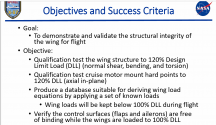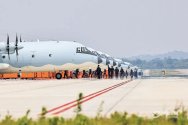Could you explain a bit more what you mean by “deliberately set”? 111% seems a bit too even even for four engine military aircrafts. What if the Y-20 had to do extreme maneuvers ( like the C17 did through valleys and downtown Sidney). Can it still do that or fly through hurricanes with 111% though? Sorry i am terrible in details of aviation physics lol. I’m political science major lol
I was only translating what the designer said in the TV program. If you watch it, you get the full answer.
The test engineer said that the test purpose is a figure between 100% and 120% load, they expect the wings to break at 120%, anything more than that means the wing is TOO strong than needed = overweight and overengineering. 111% is the final result from that test which sit in the middle of the desired figures. That is what I meant "deliberate". However, now I think again, I must emphasize that the test engineer's words must be treated as specific to that test (alone) in the video, not something about Y-20's production models.
As of 111% being too low, see my explaination to sunnymaxi below.
its actually 120% as per the video.. still low considering other Military airlifter.
C919 achieved 150% back in 2018. so i doubt there was a bottleneck or some material limit of AVIC from 2015 onward.
View attachment 122205
this 'destructive test footage' is from early variant of Y-20.
i believe Y-20B is a lot different aircraft as compared to early variants.
waiting for
@taxiya answer..
I watched the video again.
The video (8:33) says that on September 28, 2014 AVIC structural strength institute conducted a "2.5G destructive test". 2.5G means 150% load (removing the static weight of 1G).

Then at 8:48 the test engineer said "we at the time set the max (test) load to 120%"

So I suspect that this specific test in the video is only one of many experiments that does not reflect the true load capacity of production Y-20 which should be 150%.
I now may have to withdraw my explaination
in #6,324 where I assumed that the 111% or 120% being the final figure of Y-20's max structure load.
My new explaination (hope no need to withdraw again

) is that it is impossible to determine the minimum material and construction work that meet the desired strengh with pure theorotic work. So a circle of trail and break is done to find that sweet spot.
The test in the video is one iteration of the circle to learn what load that specific construction can achieve. It is a process to accumulate data and experience to assist future design. XAC probably would have done some enforcement here and there in the next iteration to see when it breaks untill they find the minimum engineering effort that reaches just above 150% which then became the construction design for production Y-20. This is part of the work to move a maiden flight prototype to a serial production design.
What confused me and probably others is that the video showed the final certification test (150%) of C919, but only one of early tests of
pre-production Y-20 (111%). Then I mistakenly equated the two as the same.







